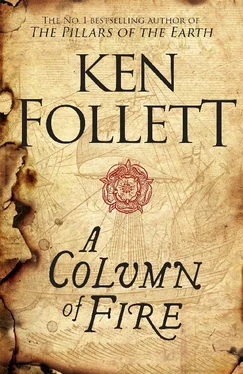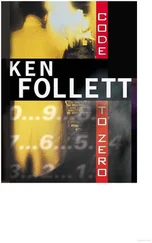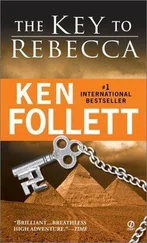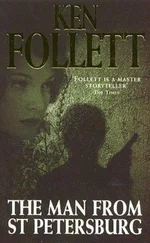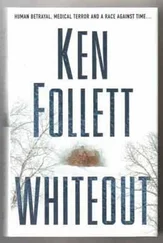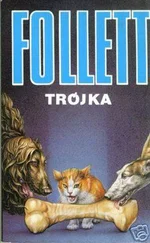Night fell, the wind freshened, and the tide turned. At midnight, wind and tide were perfect. The skeleton crews hoisted sails and steered the lightless fireships towards the glimmering lamps of the Spanish armada. Ned strained to see, but there was no moon yet, and the ships were dark blurs on a dark sea. The distance between the two fleets was only half a mile, but the wait seemed interminable. Ned’s heart raced. Everything hung on this. He did not often pray, but now he sent a fervent request to heaven.
Suddenly light flared. One after another the eight ships burst into flame. Against the red conflagration Ned could see the sailors leaping to their escape boats. The eight separate blazes soon seemed to join together and become one inferno. And the wind blew the firebomb inexorably towards the enemy fleet.
Rollo watched with his heart thudding and his breath coming in gasps. The fireships approached the screen of small vessels that Medina Sidonia had deployed to hamper them. The smoke that filled Rollo’s nostrils smelled of wood and tar. He could even feel the heat of the flames.
Two pinnaces now detached themselves from the screen and moved towards either end of the line of fireships. The crews, risking their lives, threw grappling irons onto the blazing vessels. As soon as they achieved a grip, each crew began to tow a fireship away. Even as he trembled for his own life, Rollo was awestruck by the courage and seamanship of those Spanish sailors. They headed for the open sea where the fireships could burn to ashes harmlessly.
Six fireships remained. Two more pinnaces, repeating the pattern, approached the outermost of the fireships. With luck, Rollo thought, all six might be detached in the same way, two by two, and rendered ineffectual. Medina Sidonia’s tactic was working. Rollo’s spirits rose.
Then he was shocked by a burst of cannon fire.
There was certainly no one alive on board the fireships, but their guns seemed to be going off by magic. Was Satan there, loading the cannons as the flames danced around him, helping the heretics? Then Rollo realized that the weapons had been pre-loaded, and had gone off when the heat ignited the gunpowder.
The result was carnage. Against the bright orange blaze of the fire he could see the black outlines of the men in the pinnaces jerk, like crazed devils cavorting in hell, as they were riddled with bullets. The cannons must have been loaded with shot or stones. The men appeared to be screaming, but nothing could be heard over the roar of the flames and the crash of the guns.
The attempt to capture and divert the fireships collapsed as the crews fell, dead or wounded, to their decks and into the sea. The fireships, carried by the tide, came on relentlessly.
At that point the Spanish had no choice but to flee.
Aboard the San Martin , Medina Sidonia fired a signal gun giving the order to weigh anchors and sail away; but it was superfluous. On every ship that Rollo could see in the orange light, the men were swarming up the masts and setting the sails. In their haste many did not raise their anchors but simply cut the arm-thick ropes with hatchets and left the anchors on the sea bed.
At first the San Martin moved with agonizing slowness. Like all the ships, it had been anchored head-on to the wind for stability; so first it had to be turned, a painstaking operation carried out with small sails. To Rollo it seemed inevitable that the galleon would catch fire before it could move away, and he got ready to jump into the water and try to swim to shore.
Medina Sidonia calmly sent a pinnace around the fleet with orders for all ships to sail north and regroup, but Rollo was not sure many would obey. The presence among them of blazing fireships was so terrifying that most sailors could think of nothing but getting away.
As they turned and the wind at last filled their sails, they had to concentrate on escaping without crashing into one another. As soon as they got clear, most ships fled as fast as wind and tide would carry them, regardless of direction.
Then a fireship sailed dangerously close to the San Martin , and flying sparks set the foresails alight.
Rollo looked down into the black water and hesitated to jump.
But the ship was prepared to fight fires. On deck were barrels of seawater and stacks of buckets. A sailor seized a bucket and threw water up at the burning canvas. Rollo grabbed another bucket and did the same. Others joined them, and they quickly extinguished the flames.
Then at last the galleon caught the wind and moved away from danger.
It stopped after a mile. Rollo looked back over the stern. The English were doing nothing. Safely to windward of the flames, they could afford to watch. The armada was still in the grip of confusion and panic. Even though none of the Spanish ships had caught fire, the danger was so immediate that it was impossible for anyone to think of anything but saving himself.
For the moment the San Martin was alone — and vulnerable. It was dark now, and no more could be done. But the ships had been saved. In the morning Medina Sidonia would face the difficult task of re-forming the armada. But it could be done. And the invasion could still go ahead.
As dawn broke over Calais, Barney Willard, on the deck of the Alice , saw that the fireships had failed. Their smouldering remains littered the Calais foreshore, but no other vessels had been burned. Only one wreck was visible, the San Lorenzo , drifting helplessly towards the cliffs.
A mile or so to the north he could make out the silhouette of the Spanish flagship, the San Martin , and four other galleons. The rest of the stupendous fleet was out of sight. They had been scattered, and their formation lost, but they were intact. As Barney looked, the five galleons he could see swung east and picked up speed. Medina Sidonia was off to round up his strays. Once he had done that, he could return to Calais in strength and still make his rendezvous with the duke of Parma.
And yet Barney felt the English now had a slim chance. The armada was vulnerable while its discipline was shattered and its ships were dispersed. They might be picked off in ones and twos.
If at the same time they could be driven towards the Netherlands sandbanks, so much the better. Barney had often negotiated those sandbanks as he sailed into Antwerp, and Drake was equally familiar with them, but to most Spanish navigators they were uncharted hazards. There was an opportunity here — though not for long.
To Barney’s profound satisfaction, Lord Howard reached the same conclusion.
The Ark Royal fired a signal gun, and Drake’s Revenge weighed anchor and raised sails. Barney shouted orders to his crew, who rubbed the sleep from their eyes and went into action all at once, like a well-trained choir commencing a madrigal.
The English navy set off in hot pursuit of the five galleons.
Barney stood on deck, effortlessly keeping his balance in the heavy seas. The August weather was blustery, the wind constantly changing strength and direction, with intermittent driving rain and patchy visibility, as happened often in the Channel. Barney relished the feeling of racing across the water, the salty air in his lungs, cold rain cooling his face, and the prospect of plunder at the end of the day.
The fast English ships gained relentlessly on the galleons, but the Spanish flight was not fruitless, for as they passed through the straits into the North Sea they picked up more of their scattered armada. Nevertheless, they remained outnumbered by the English, who drew ever closer.
It was nine o’clock in the morning, and by Barney’s calculation they were about seven miles off the Netherlands town of Gravelines, when Medina Sidonia decided that further flight was pointless, and turned to face his enemy.
Читать дальше
